MGT604 - Impact of Globalization on Cross-Cultural Communication
VerifiedAdded on 2023/05/28
|14
|3495
|422
Essay
AI Summary
This essay examines the impact of globalization on cross-cultural communication within the Australian supermarket industry. It addresses the research questions related to the structure and efficiency of the supermarket industry in Australia, the major drivers of structural changes, and how globalization affects the way organizations manage diversity in the workplace. The essay further explores how organizations can achieve success in a multicultural context through effective communication, discussing barriers such as misunderstanding, norms, beliefs, values, stereotyping, and ethnocentrism. It reviews different cultural dimensions and models of communication, including the Lewis model, Trompenaars and Hampden-Turner's seven dimensions, and Hofstede's cultural dimensions. The analysis delves into the Australian retail industry's exposure to international influences, the impact of the 'Fair Work System,' and the characteristics of the retail workforce, including age, working hours, and skill levels. It also addresses the treatment of suppliers and concludes with recommendations for improving cross-cultural communication in the workplace.
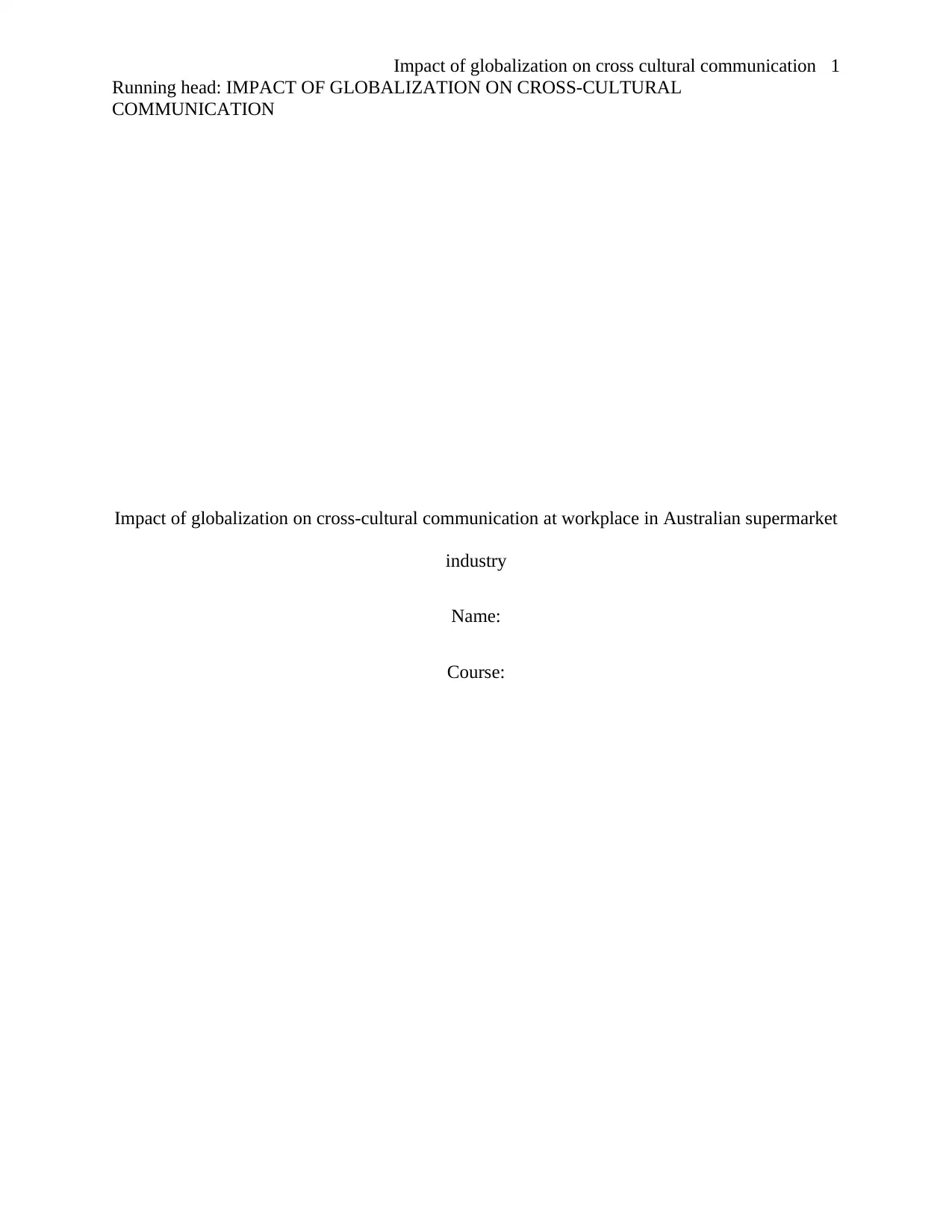
1Impact of globalization on cross cultural communication
Running head: IMPACT OF GLOBALIZATION ON CROSS-CULTURAL
COMMUNICATION
Impact of globalization on cross-cultural communication at workplace in Australian supermarket
industry
Name:
Course:
Running head: IMPACT OF GLOBALIZATION ON CROSS-CULTURAL
COMMUNICATION
Impact of globalization on cross-cultural communication at workplace in Australian supermarket
industry
Name:
Course:
Paraphrase This Document
Need a fresh take? Get an instant paraphrase of this document with our AI Paraphraser
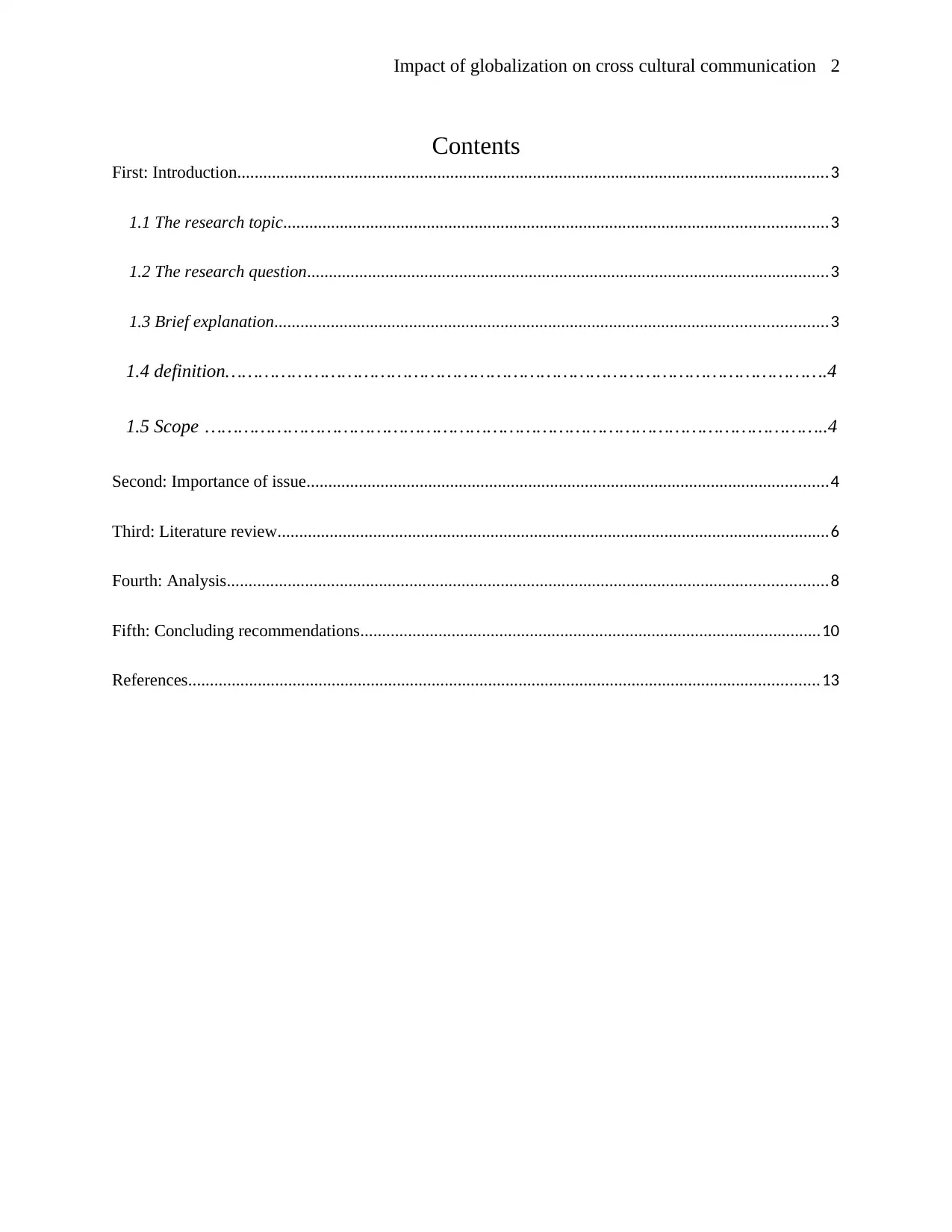
2Impact of globalization on cross cultural communication
Contents
First: Introduction........................................................................................................................................3
1.1 The research topic.............................................................................................................................3
1.2 The research question........................................................................................................................3
1.3 Brief explanation...............................................................................................................................3
1.4 definition……………………………………………………………………………………………….4
1.5 Scope …………………………………………………………………………………………………..4
Second: Importance of issue........................................................................................................................4
Third: Literature review...............................................................................................................................6
Fourth: Analysis..........................................................................................................................................8
Fifth: Concluding recommendations..........................................................................................................10
References.................................................................................................................................................13
Contents
First: Introduction........................................................................................................................................3
1.1 The research topic.............................................................................................................................3
1.2 The research question........................................................................................................................3
1.3 Brief explanation...............................................................................................................................3
1.4 definition……………………………………………………………………………………………….4
1.5 Scope …………………………………………………………………………………………………..4
Second: Importance of issue........................................................................................................................4
Third: Literature review...............................................................................................................................6
Fourth: Analysis..........................................................................................................................................8
Fifth: Concluding recommendations..........................................................................................................10
References.................................................................................................................................................13
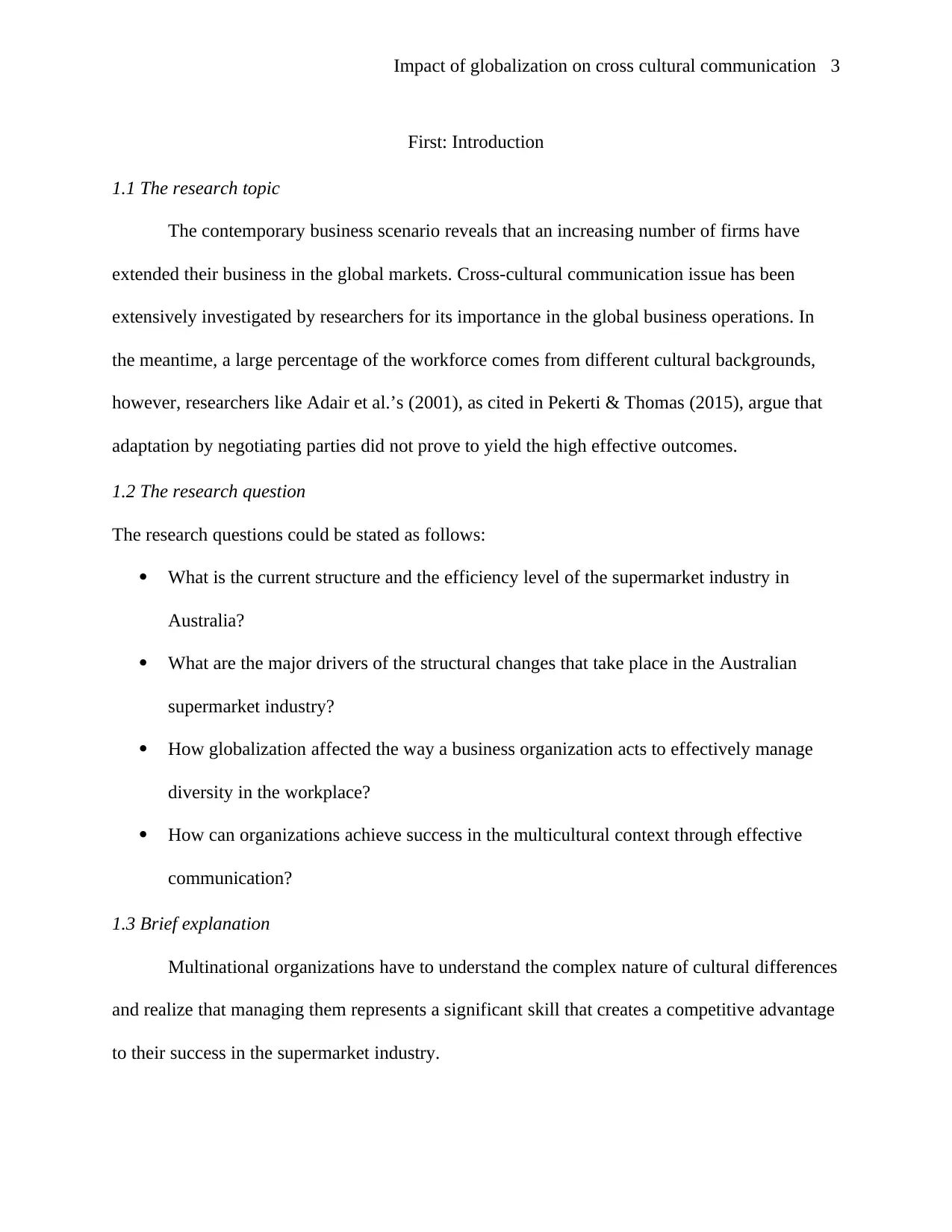
3Impact of globalization on cross cultural communication
First: Introduction
1.1 The research topic
The contemporary business scenario reveals that an increasing number of firms have
extended their business in the global markets. Cross-cultural communication issue has been
extensively investigated by researchers for its importance in the global business operations. In
the meantime, a large percentage of the workforce comes from different cultural backgrounds,
however, researchers like Adair et al.’s (2001), as cited in Pekerti & Thomas (2015), argue that
adaptation by negotiating parties did not prove to yield the high effective outcomes.
1.2 The research question
The research questions could be stated as follows:
What is the current structure and the efficiency level of the supermarket industry in
Australia?
What are the major drivers of the structural changes that take place in the Australian
supermarket industry?
How globalization affected the way a business organization acts to effectively manage
diversity in the workplace?
How can organizations achieve success in the multicultural context through effective
communication?
1.3 Brief explanation
Multinational organizations have to understand the complex nature of cultural differences
and realize that managing them represents a significant skill that creates a competitive advantage
to their success in the supermarket industry.
First: Introduction
1.1 The research topic
The contemporary business scenario reveals that an increasing number of firms have
extended their business in the global markets. Cross-cultural communication issue has been
extensively investigated by researchers for its importance in the global business operations. In
the meantime, a large percentage of the workforce comes from different cultural backgrounds,
however, researchers like Adair et al.’s (2001), as cited in Pekerti & Thomas (2015), argue that
adaptation by negotiating parties did not prove to yield the high effective outcomes.
1.2 The research question
The research questions could be stated as follows:
What is the current structure and the efficiency level of the supermarket industry in
Australia?
What are the major drivers of the structural changes that take place in the Australian
supermarket industry?
How globalization affected the way a business organization acts to effectively manage
diversity in the workplace?
How can organizations achieve success in the multicultural context through effective
communication?
1.3 Brief explanation
Multinational organizations have to understand the complex nature of cultural differences
and realize that managing them represents a significant skill that creates a competitive advantage
to their success in the supermarket industry.
⊘ This is a preview!⊘
Do you want full access?
Subscribe today to unlock all pages.

Trusted by 1+ million students worldwide
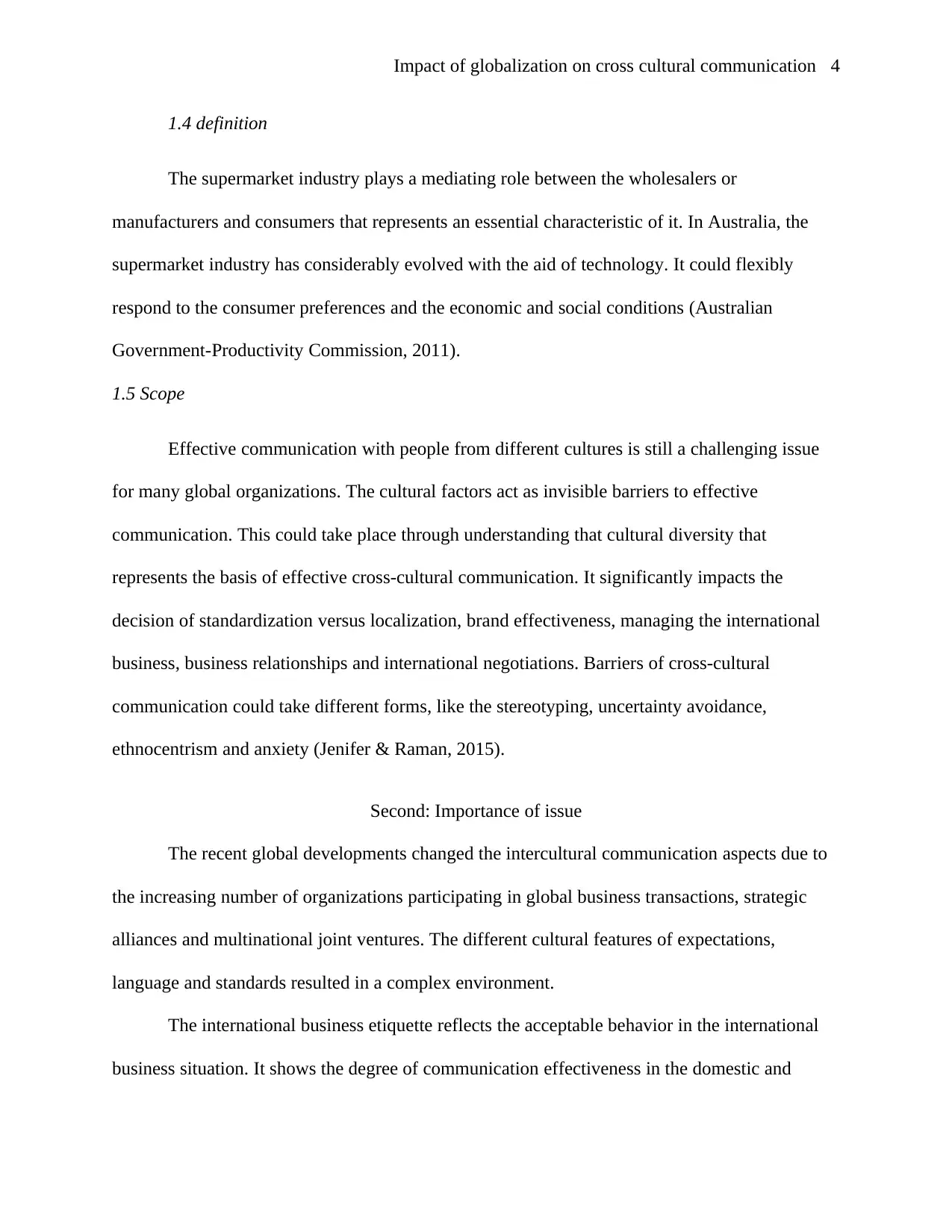
4Impact of globalization on cross cultural communication
1.4 definition
The supermarket industry plays a mediating role between the wholesalers or
manufacturers and consumers that represents an essential characteristic of it. In Australia, the
supermarket industry has considerably evolved with the aid of technology. It could flexibly
respond to the consumer preferences and the economic and social conditions (Australian
Government-Productivity Commission, 2011).
1.5 Scope
Effective communication with people from different cultures is still a challenging issue
for many global organizations. The cultural factors act as invisible barriers to effective
communication. This could take place through understanding that cultural diversity that
represents the basis of effective cross-cultural communication. It significantly impacts the
decision of standardization versus localization, brand effectiveness, managing the international
business, business relationships and international negotiations. Barriers of cross-cultural
communication could take different forms, like the stereotyping, uncertainty avoidance,
ethnocentrism and anxiety (Jenifer & Raman, 2015).
Second: Importance of issue
The recent global developments changed the intercultural communication aspects due to
the increasing number of organizations participating in global business transactions, strategic
alliances and multinational joint ventures. The different cultural features of expectations,
language and standards resulted in a complex environment.
The international business etiquette reflects the acceptable behavior in the international
business situation. It shows the degree of communication effectiveness in the domestic and
1.4 definition
The supermarket industry plays a mediating role between the wholesalers or
manufacturers and consumers that represents an essential characteristic of it. In Australia, the
supermarket industry has considerably evolved with the aid of technology. It could flexibly
respond to the consumer preferences and the economic and social conditions (Australian
Government-Productivity Commission, 2011).
1.5 Scope
Effective communication with people from different cultures is still a challenging issue
for many global organizations. The cultural factors act as invisible barriers to effective
communication. This could take place through understanding that cultural diversity that
represents the basis of effective cross-cultural communication. It significantly impacts the
decision of standardization versus localization, brand effectiveness, managing the international
business, business relationships and international negotiations. Barriers of cross-cultural
communication could take different forms, like the stereotyping, uncertainty avoidance,
ethnocentrism and anxiety (Jenifer & Raman, 2015).
Second: Importance of issue
The recent global developments changed the intercultural communication aspects due to
the increasing number of organizations participating in global business transactions, strategic
alliances and multinational joint ventures. The different cultural features of expectations,
language and standards resulted in a complex environment.
The international business etiquette reflects the acceptable behavior in the international
business situation. It shows the degree of communication effectiveness in the domestic and
Paraphrase This Document
Need a fresh take? Get an instant paraphrase of this document with our AI Paraphraser
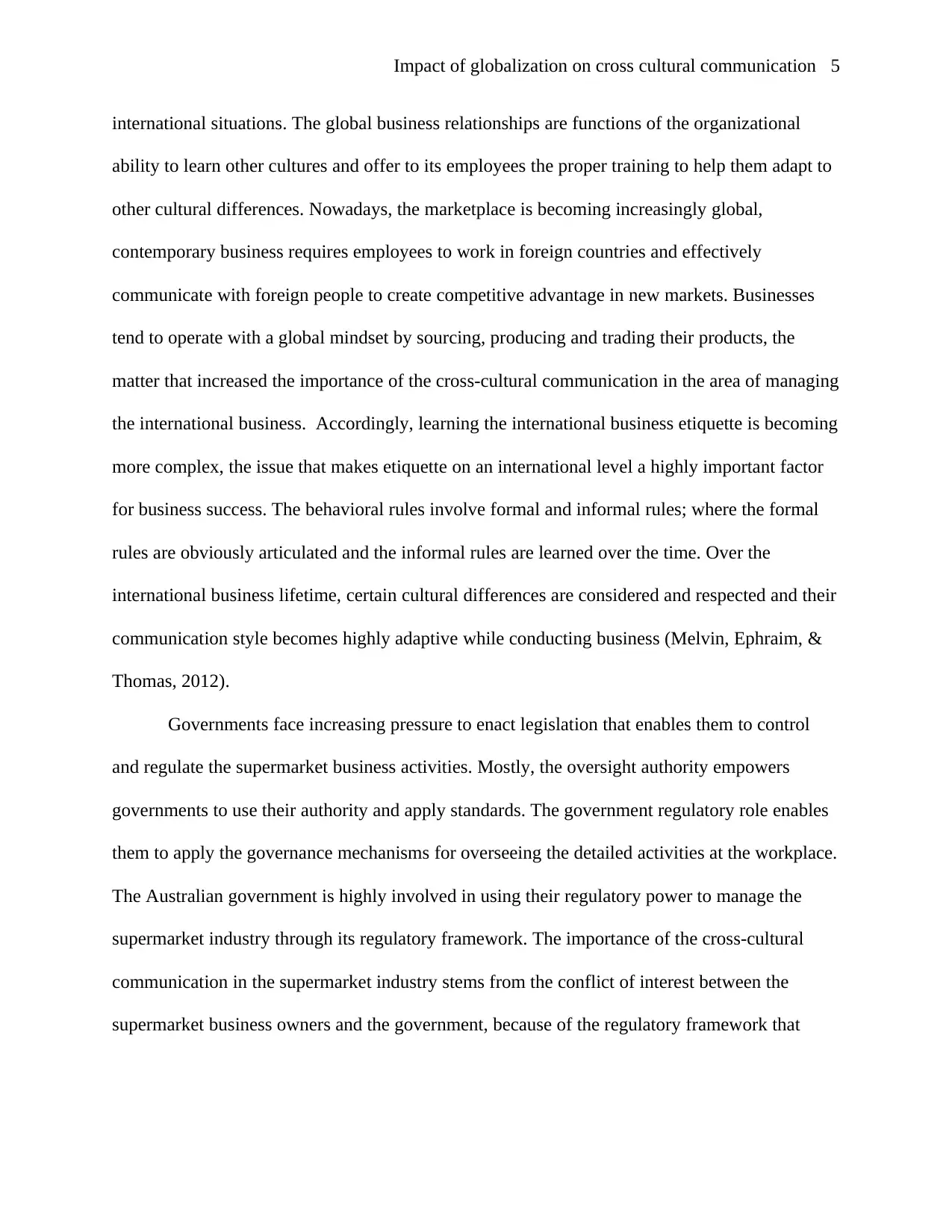
5Impact of globalization on cross cultural communication
international situations. The global business relationships are functions of the organizational
ability to learn other cultures and offer to its employees the proper training to help them adapt to
other cultural differences. Nowadays, the marketplace is becoming increasingly global,
contemporary business requires employees to work in foreign countries and effectively
communicate with foreign people to create competitive advantage in new markets. Businesses
tend to operate with a global mindset by sourcing, producing and trading their products, the
matter that increased the importance of the cross-cultural communication in the area of managing
the international business. Accordingly, learning the international business etiquette is becoming
more complex, the issue that makes etiquette on an international level a highly important factor
for business success. The behavioral rules involve formal and informal rules; where the formal
rules are obviously articulated and the informal rules are learned over the time. Over the
international business lifetime, certain cultural differences are considered and respected and their
communication style becomes highly adaptive while conducting business (Melvin, Ephraim, &
Thomas, 2012).
Governments face increasing pressure to enact legislation that enables them to control
and regulate the supermarket business activities. Mostly, the oversight authority empowers
governments to use their authority and apply standards. The government regulatory role enables
them to apply the governance mechanisms for overseeing the detailed activities at the workplace.
The Australian government is highly involved in using their regulatory power to manage the
supermarket industry through its regulatory framework. The importance of the cross-cultural
communication in the supermarket industry stems from the conflict of interest between the
supermarket business owners and the government, because of the regulatory framework that
international situations. The global business relationships are functions of the organizational
ability to learn other cultures and offer to its employees the proper training to help them adapt to
other cultural differences. Nowadays, the marketplace is becoming increasingly global,
contemporary business requires employees to work in foreign countries and effectively
communicate with foreign people to create competitive advantage in new markets. Businesses
tend to operate with a global mindset by sourcing, producing and trading their products, the
matter that increased the importance of the cross-cultural communication in the area of managing
the international business. Accordingly, learning the international business etiquette is becoming
more complex, the issue that makes etiquette on an international level a highly important factor
for business success. The behavioral rules involve formal and informal rules; where the formal
rules are obviously articulated and the informal rules are learned over the time. Over the
international business lifetime, certain cultural differences are considered and respected and their
communication style becomes highly adaptive while conducting business (Melvin, Ephraim, &
Thomas, 2012).
Governments face increasing pressure to enact legislation that enables them to control
and regulate the supermarket business activities. Mostly, the oversight authority empowers
governments to use their authority and apply standards. The government regulatory role enables
them to apply the governance mechanisms for overseeing the detailed activities at the workplace.
The Australian government is highly involved in using their regulatory power to manage the
supermarket industry through its regulatory framework. The importance of the cross-cultural
communication in the supermarket industry stems from the conflict of interest between the
supermarket business owners and the government, because of the regulatory framework that
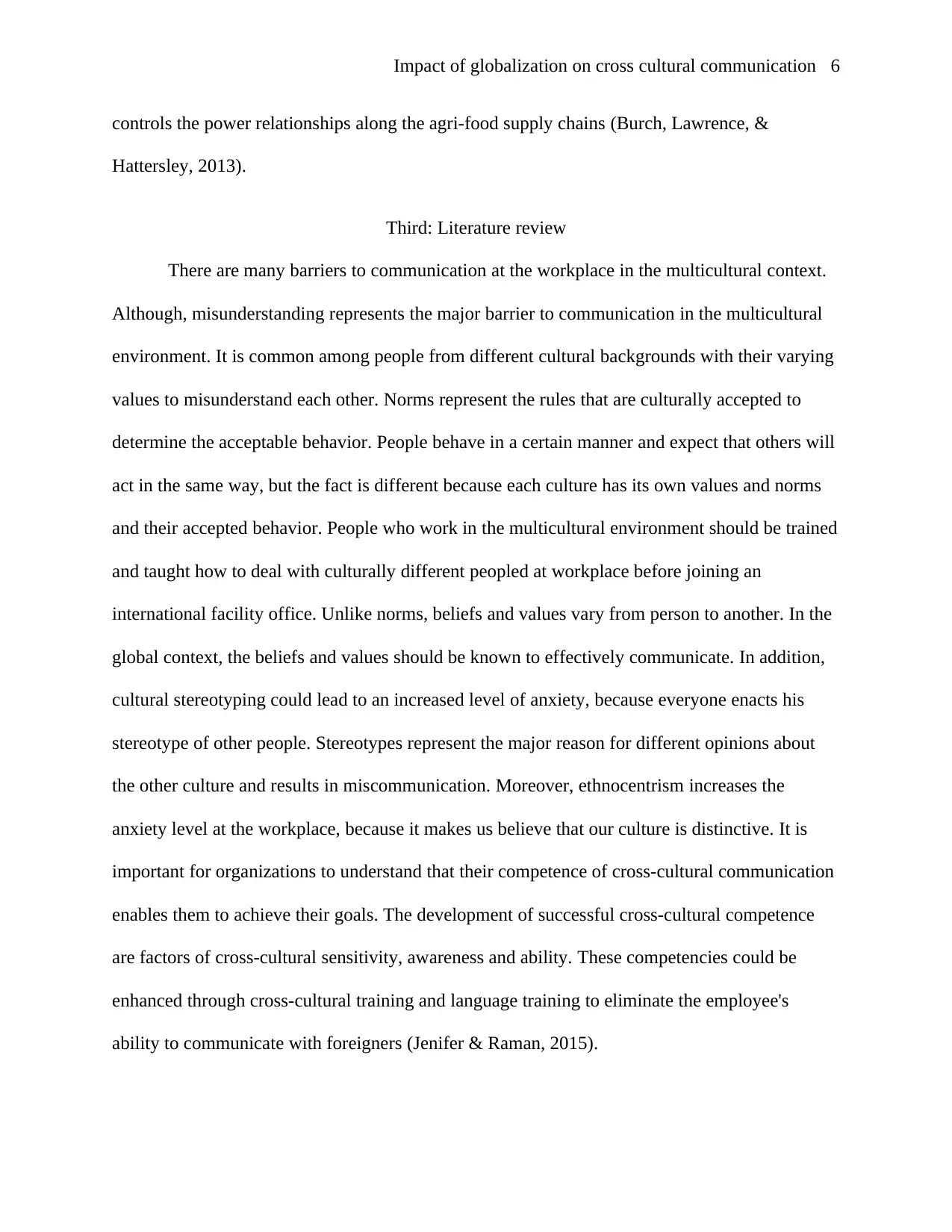
6Impact of globalization on cross cultural communication
controls the power relationships along the agri-food supply chains (Burch, Lawrence, &
Hattersley, 2013).
Third: Literature review
There are many barriers to communication at the workplace in the multicultural context.
Although, misunderstanding represents the major barrier to communication in the multicultural
environment. It is common among people from different cultural backgrounds with their varying
values to misunderstand each other. Norms represent the rules that are culturally accepted to
determine the acceptable behavior. People behave in a certain manner and expect that others will
act in the same way, but the fact is different because each culture has its own values and norms
and their accepted behavior. People who work in the multicultural environment should be trained
and taught how to deal with culturally different peopled at workplace before joining an
international facility office. Unlike norms, beliefs and values vary from person to another. In the
global context, the beliefs and values should be known to effectively communicate. In addition,
cultural stereotyping could lead to an increased level of anxiety, because everyone enacts his
stereotype of other people. Stereotypes represent the major reason for different opinions about
the other culture and results in miscommunication. Moreover, ethnocentrism increases the
anxiety level at the workplace, because it makes us believe that our culture is distinctive. It is
important for organizations to understand that their competence of cross-cultural communication
enables them to achieve their goals. The development of successful cross-cultural competence
are factors of cross-cultural sensitivity, awareness and ability. These competencies could be
enhanced through cross-cultural training and language training to eliminate the employee's
ability to communicate with foreigners (Jenifer & Raman, 2015).
controls the power relationships along the agri-food supply chains (Burch, Lawrence, &
Hattersley, 2013).
Third: Literature review
There are many barriers to communication at the workplace in the multicultural context.
Although, misunderstanding represents the major barrier to communication in the multicultural
environment. It is common among people from different cultural backgrounds with their varying
values to misunderstand each other. Norms represent the rules that are culturally accepted to
determine the acceptable behavior. People behave in a certain manner and expect that others will
act in the same way, but the fact is different because each culture has its own values and norms
and their accepted behavior. People who work in the multicultural environment should be trained
and taught how to deal with culturally different peopled at workplace before joining an
international facility office. Unlike norms, beliefs and values vary from person to another. In the
global context, the beliefs and values should be known to effectively communicate. In addition,
cultural stereotyping could lead to an increased level of anxiety, because everyone enacts his
stereotype of other people. Stereotypes represent the major reason for different opinions about
the other culture and results in miscommunication. Moreover, ethnocentrism increases the
anxiety level at the workplace, because it makes us believe that our culture is distinctive. It is
important for organizations to understand that their competence of cross-cultural communication
enables them to achieve their goals. The development of successful cross-cultural competence
are factors of cross-cultural sensitivity, awareness and ability. These competencies could be
enhanced through cross-cultural training and language training to eliminate the employee's
ability to communicate with foreigners (Jenifer & Raman, 2015).
⊘ This is a preview!⊘
Do you want full access?
Subscribe today to unlock all pages.

Trusted by 1+ million students worldwide
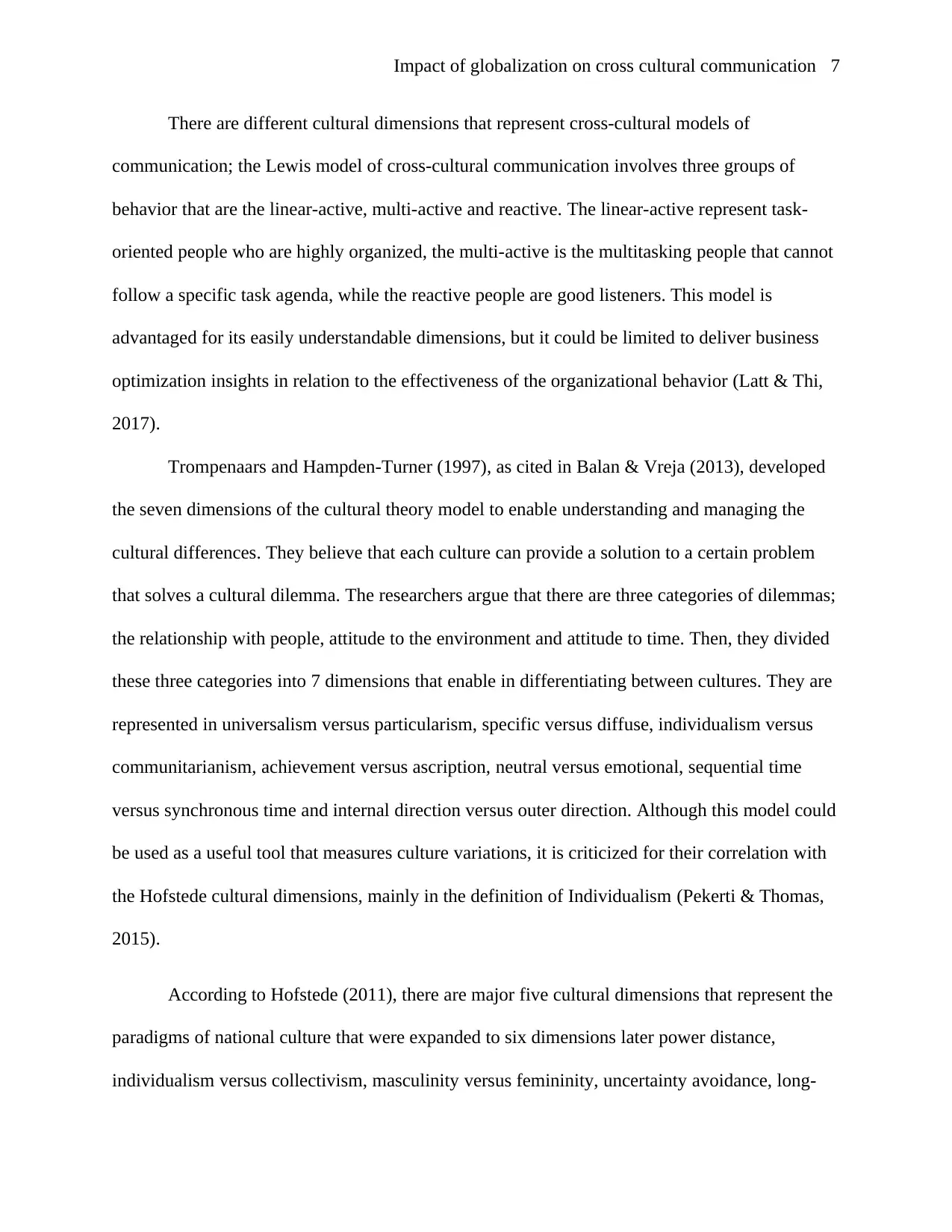
7Impact of globalization on cross cultural communication
There are different cultural dimensions that represent cross-cultural models of
communication; the Lewis model of cross-cultural communication involves three groups of
behavior that are the linear-active, multi-active and reactive. The linear-active represent task-
oriented people who are highly organized, the multi-active is the multitasking people that cannot
follow a specific task agenda, while the reactive people are good listeners. This model is
advantaged for its easily understandable dimensions, but it could be limited to deliver business
optimization insights in relation to the effectiveness of the organizational behavior (Latt & Thi,
2017).
Trompenaars and Hampden-Turner (1997), as cited in Balan & Vreja (2013), developed
the seven dimensions of the cultural theory model to enable understanding and managing the
cultural differences. They believe that each culture can provide a solution to a certain problem
that solves a cultural dilemma. The researchers argue that there are three categories of dilemmas;
the relationship with people, attitude to the environment and attitude to time. Then, they divided
these three categories into 7 dimensions that enable in differentiating between cultures. They are
represented in universalism versus particularism, specific versus diffuse, individualism versus
communitarianism, achievement versus ascription, neutral versus emotional, sequential time
versus synchronous time and internal direction versus outer direction. Although this model could
be used as a useful tool that measures culture variations, it is criticized for their correlation with
the Hofstede cultural dimensions, mainly in the definition of Individualism (Pekerti & Thomas,
2015).
According to Hofstede (2011), there are major five cultural dimensions that represent the
paradigms of national culture that were expanded to six dimensions later power distance,
individualism versus collectivism, masculinity versus femininity, uncertainty avoidance, long-
There are different cultural dimensions that represent cross-cultural models of
communication; the Lewis model of cross-cultural communication involves three groups of
behavior that are the linear-active, multi-active and reactive. The linear-active represent task-
oriented people who are highly organized, the multi-active is the multitasking people that cannot
follow a specific task agenda, while the reactive people are good listeners. This model is
advantaged for its easily understandable dimensions, but it could be limited to deliver business
optimization insights in relation to the effectiveness of the organizational behavior (Latt & Thi,
2017).
Trompenaars and Hampden-Turner (1997), as cited in Balan & Vreja (2013), developed
the seven dimensions of the cultural theory model to enable understanding and managing the
cultural differences. They believe that each culture can provide a solution to a certain problem
that solves a cultural dilemma. The researchers argue that there are three categories of dilemmas;
the relationship with people, attitude to the environment and attitude to time. Then, they divided
these three categories into 7 dimensions that enable in differentiating between cultures. They are
represented in universalism versus particularism, specific versus diffuse, individualism versus
communitarianism, achievement versus ascription, neutral versus emotional, sequential time
versus synchronous time and internal direction versus outer direction. Although this model could
be used as a useful tool that measures culture variations, it is criticized for their correlation with
the Hofstede cultural dimensions, mainly in the definition of Individualism (Pekerti & Thomas,
2015).
According to Hofstede (2011), there are major five cultural dimensions that represent the
paradigms of national culture that were expanded to six dimensions later power distance,
individualism versus collectivism, masculinity versus femininity, uncertainty avoidance, long-
Paraphrase This Document
Need a fresh take? Get an instant paraphrase of this document with our AI Paraphraser
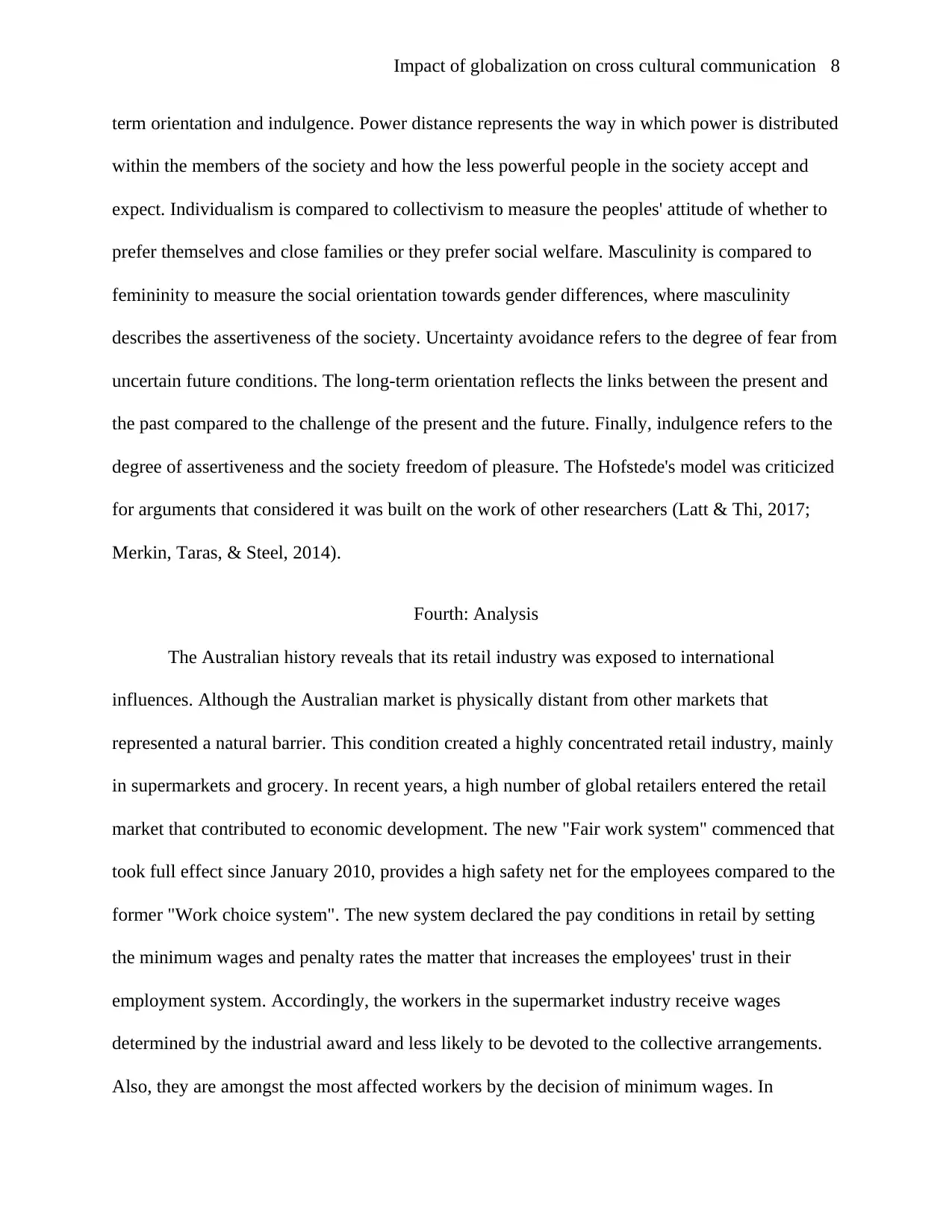
8Impact of globalization on cross cultural communication
term orientation and indulgence. Power distance represents the way in which power is distributed
within the members of the society and how the less powerful people in the society accept and
expect. Individualism is compared to collectivism to measure the peoples' attitude of whether to
prefer themselves and close families or they prefer social welfare. Masculinity is compared to
femininity to measure the social orientation towards gender differences, where masculinity
describes the assertiveness of the society. Uncertainty avoidance refers to the degree of fear from
uncertain future conditions. The long-term orientation reflects the links between the present and
the past compared to the challenge of the present and the future. Finally, indulgence refers to the
degree of assertiveness and the society freedom of pleasure. The Hofstede's model was criticized
for arguments that considered it was built on the work of other researchers (Latt & Thi, 2017;
Merkin, Taras, & Steel, 2014).
Fourth: Analysis
The Australian history reveals that its retail industry was exposed to international
influences. Although the Australian market is physically distant from other markets that
represented a natural barrier. This condition created a highly concentrated retail industry, mainly
in supermarkets and grocery. In recent years, a high number of global retailers entered the retail
market that contributed to economic development. The new "Fair work system" commenced that
took full effect since January 2010, provides a high safety net for the employees compared to the
former "Work choice system". The new system declared the pay conditions in retail by setting
the minimum wages and penalty rates the matter that increases the employees' trust in their
employment system. Accordingly, the workers in the supermarket industry receive wages
determined by the industrial award and less likely to be devoted to the collective arrangements.
Also, they are amongst the most affected workers by the decision of minimum wages. In
term orientation and indulgence. Power distance represents the way in which power is distributed
within the members of the society and how the less powerful people in the society accept and
expect. Individualism is compared to collectivism to measure the peoples' attitude of whether to
prefer themselves and close families or they prefer social welfare. Masculinity is compared to
femininity to measure the social orientation towards gender differences, where masculinity
describes the assertiveness of the society. Uncertainty avoidance refers to the degree of fear from
uncertain future conditions. The long-term orientation reflects the links between the present and
the past compared to the challenge of the present and the future. Finally, indulgence refers to the
degree of assertiveness and the society freedom of pleasure. The Hofstede's model was criticized
for arguments that considered it was built on the work of other researchers (Latt & Thi, 2017;
Merkin, Taras, & Steel, 2014).
Fourth: Analysis
The Australian history reveals that its retail industry was exposed to international
influences. Although the Australian market is physically distant from other markets that
represented a natural barrier. This condition created a highly concentrated retail industry, mainly
in supermarkets and grocery. In recent years, a high number of global retailers entered the retail
market that contributed to economic development. The new "Fair work system" commenced that
took full effect since January 2010, provides a high safety net for the employees compared to the
former "Work choice system". The new system declared the pay conditions in retail by setting
the minimum wages and penalty rates the matter that increases the employees' trust in their
employment system. Accordingly, the workers in the supermarket industry receive wages
determined by the industrial award and less likely to be devoted to the collective arrangements.
Also, they are amongst the most affected workers by the decision of minimum wages. In
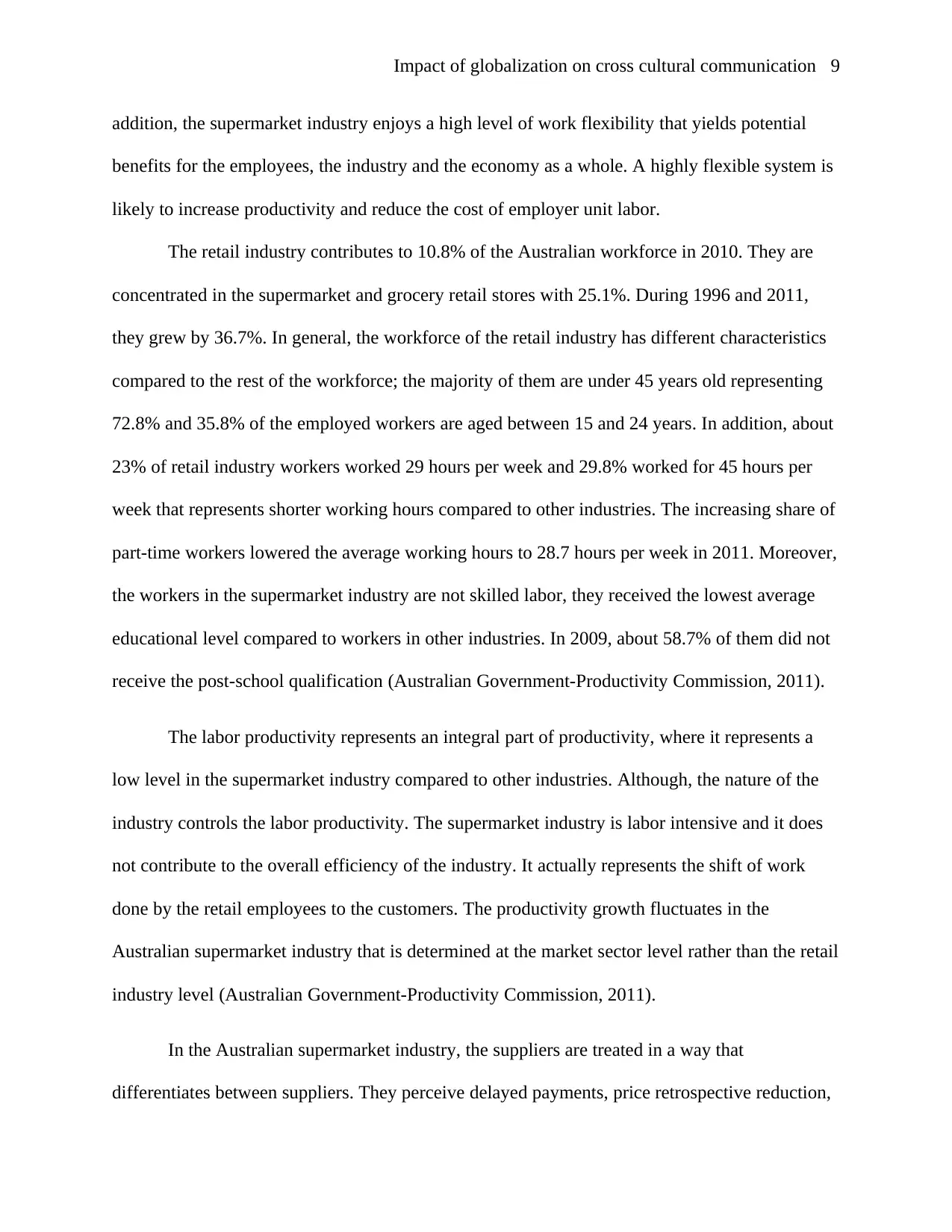
9Impact of globalization on cross cultural communication
addition, the supermarket industry enjoys a high level of work flexibility that yields potential
benefits for the employees, the industry and the economy as a whole. A highly flexible system is
likely to increase productivity and reduce the cost of employer unit labor.
The retail industry contributes to 10.8% of the Australian workforce in 2010. They are
concentrated in the supermarket and grocery retail stores with 25.1%. During 1996 and 2011,
they grew by 36.7%. In general, the workforce of the retail industry has different characteristics
compared to the rest of the workforce; the majority of them are under 45 years old representing
72.8% and 35.8% of the employed workers are aged between 15 and 24 years. In addition, about
23% of retail industry workers worked 29 hours per week and 29.8% worked for 45 hours per
week that represents shorter working hours compared to other industries. The increasing share of
part-time workers lowered the average working hours to 28.7 hours per week in 2011. Moreover,
the workers in the supermarket industry are not skilled labor, they received the lowest average
educational level compared to workers in other industries. In 2009, about 58.7% of them did not
receive the post-school qualification (Australian Government-Productivity Commission, 2011).
The labor productivity represents an integral part of productivity, where it represents a
low level in the supermarket industry compared to other industries. Although, the nature of the
industry controls the labor productivity. The supermarket industry is labor intensive and it does
not contribute to the overall efficiency of the industry. It actually represents the shift of work
done by the retail employees to the customers. The productivity growth fluctuates in the
Australian supermarket industry that is determined at the market sector level rather than the retail
industry level (Australian Government-Productivity Commission, 2011).
In the Australian supermarket industry, the suppliers are treated in a way that
differentiates between suppliers. They perceive delayed payments, price retrospective reduction,
addition, the supermarket industry enjoys a high level of work flexibility that yields potential
benefits for the employees, the industry and the economy as a whole. A highly flexible system is
likely to increase productivity and reduce the cost of employer unit labor.
The retail industry contributes to 10.8% of the Australian workforce in 2010. They are
concentrated in the supermarket and grocery retail stores with 25.1%. During 1996 and 2011,
they grew by 36.7%. In general, the workforce of the retail industry has different characteristics
compared to the rest of the workforce; the majority of them are under 45 years old representing
72.8% and 35.8% of the employed workers are aged between 15 and 24 years. In addition, about
23% of retail industry workers worked 29 hours per week and 29.8% worked for 45 hours per
week that represents shorter working hours compared to other industries. The increasing share of
part-time workers lowered the average working hours to 28.7 hours per week in 2011. Moreover,
the workers in the supermarket industry are not skilled labor, they received the lowest average
educational level compared to workers in other industries. In 2009, about 58.7% of them did not
receive the post-school qualification (Australian Government-Productivity Commission, 2011).
The labor productivity represents an integral part of productivity, where it represents a
low level in the supermarket industry compared to other industries. Although, the nature of the
industry controls the labor productivity. The supermarket industry is labor intensive and it does
not contribute to the overall efficiency of the industry. It actually represents the shift of work
done by the retail employees to the customers. The productivity growth fluctuates in the
Australian supermarket industry that is determined at the market sector level rather than the retail
industry level (Australian Government-Productivity Commission, 2011).
In the Australian supermarket industry, the suppliers are treated in a way that
differentiates between suppliers. They perceive delayed payments, price retrospective reduction,
⊘ This is a preview!⊘
Do you want full access?
Subscribe today to unlock all pages.

Trusted by 1+ million students worldwide
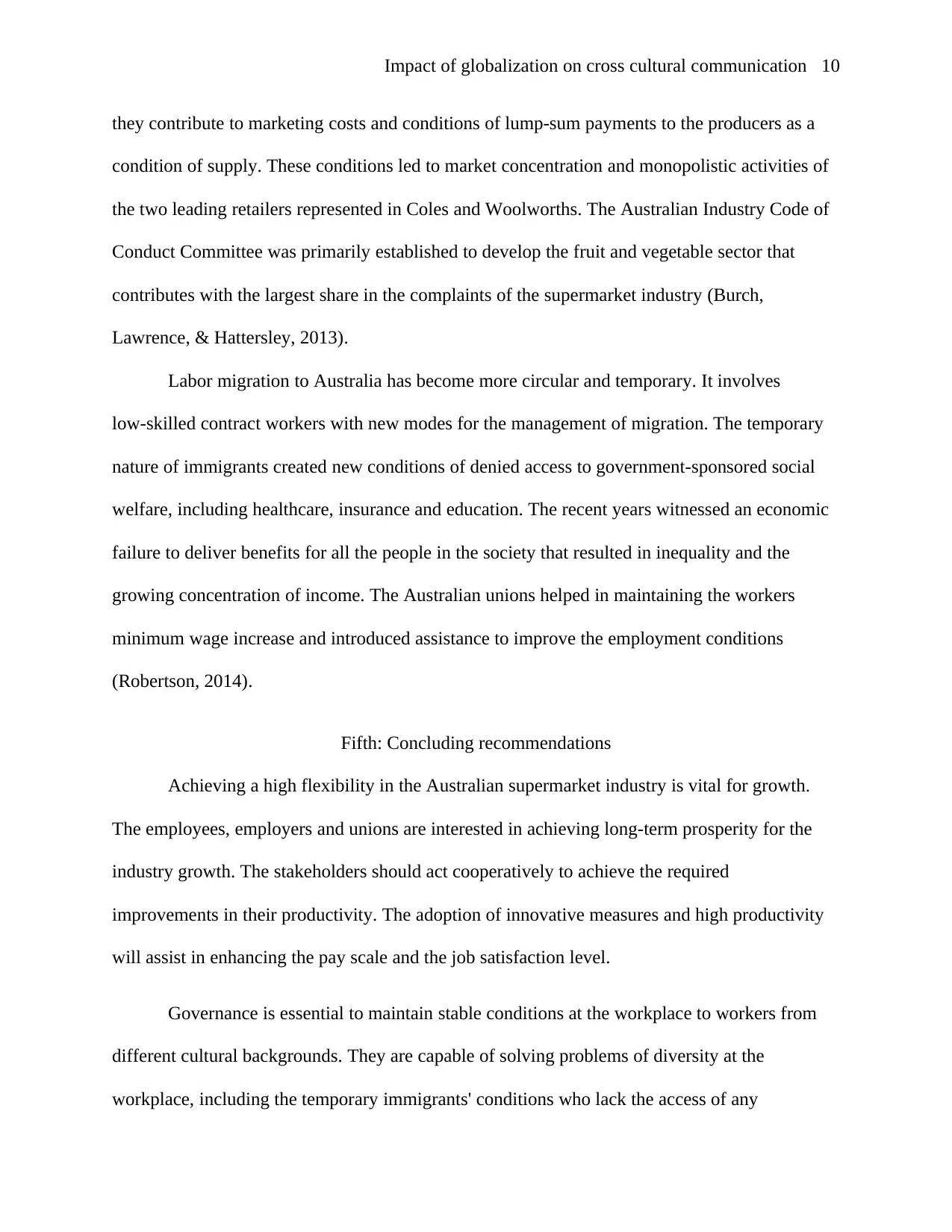
10Impact of globalization on cross cultural communication
they contribute to marketing costs and conditions of lump-sum payments to the producers as a
condition of supply. These conditions led to market concentration and monopolistic activities of
the two leading retailers represented in Coles and Woolworths. The Australian Industry Code of
Conduct Committee was primarily established to develop the fruit and vegetable sector that
contributes with the largest share in the complaints of the supermarket industry (Burch,
Lawrence, & Hattersley, 2013).
Labor migration to Australia has become more circular and temporary. It involves
low-skilled contract workers with new modes for the management of migration. The temporary
nature of immigrants created new conditions of denied access to government-sponsored social
welfare, including healthcare, insurance and education. The recent years witnessed an economic
failure to deliver benefits for all the people in the society that resulted in inequality and the
growing concentration of income. The Australian unions helped in maintaining the workers
minimum wage increase and introduced assistance to improve the employment conditions
(Robertson, 2014).
Fifth: Concluding recommendations
Achieving a high flexibility in the Australian supermarket industry is vital for growth.
The employees, employers and unions are interested in achieving long-term prosperity for the
industry growth. The stakeholders should act cooperatively to achieve the required
improvements in their productivity. The adoption of innovative measures and high productivity
will assist in enhancing the pay scale and the job satisfaction level.
Governance is essential to maintain stable conditions at the workplace to workers from
different cultural backgrounds. They are capable of solving problems of diversity at the
workplace, including the temporary immigrants' conditions who lack the access of any
they contribute to marketing costs and conditions of lump-sum payments to the producers as a
condition of supply. These conditions led to market concentration and monopolistic activities of
the two leading retailers represented in Coles and Woolworths. The Australian Industry Code of
Conduct Committee was primarily established to develop the fruit and vegetable sector that
contributes with the largest share in the complaints of the supermarket industry (Burch,
Lawrence, & Hattersley, 2013).
Labor migration to Australia has become more circular and temporary. It involves
low-skilled contract workers with new modes for the management of migration. The temporary
nature of immigrants created new conditions of denied access to government-sponsored social
welfare, including healthcare, insurance and education. The recent years witnessed an economic
failure to deliver benefits for all the people in the society that resulted in inequality and the
growing concentration of income. The Australian unions helped in maintaining the workers
minimum wage increase and introduced assistance to improve the employment conditions
(Robertson, 2014).
Fifth: Concluding recommendations
Achieving a high flexibility in the Australian supermarket industry is vital for growth.
The employees, employers and unions are interested in achieving long-term prosperity for the
industry growth. The stakeholders should act cooperatively to achieve the required
improvements in their productivity. The adoption of innovative measures and high productivity
will assist in enhancing the pay scale and the job satisfaction level.
Governance is essential to maintain stable conditions at the workplace to workers from
different cultural backgrounds. They are capable of solving problems of diversity at the
workplace, including the temporary immigrants' conditions who lack the access of any
Paraphrase This Document
Need a fresh take? Get an instant paraphrase of this document with our AI Paraphraser
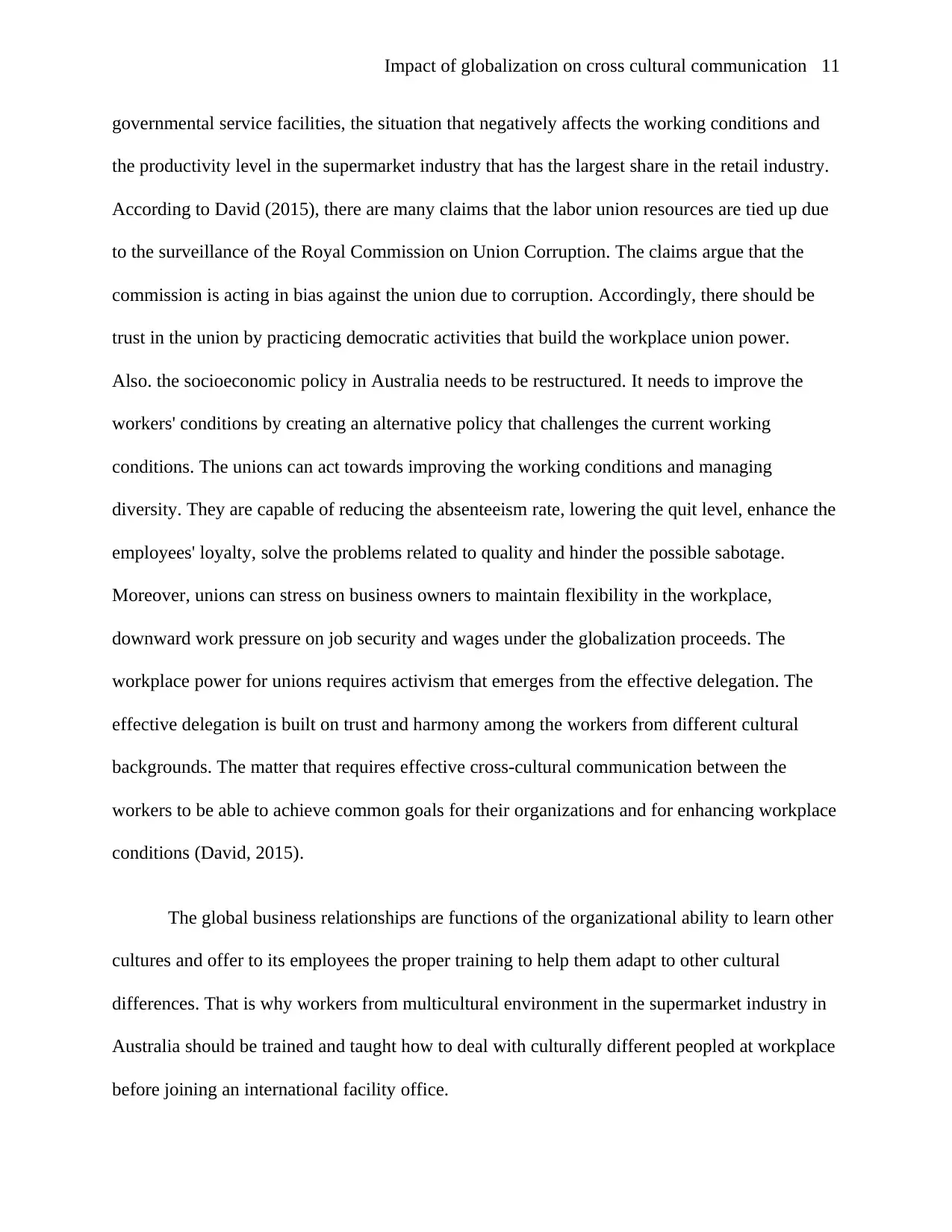
11Impact of globalization on cross cultural communication
governmental service facilities, the situation that negatively affects the working conditions and
the productivity level in the supermarket industry that has the largest share in the retail industry.
According to David (2015), there are many claims that the labor union resources are tied up due
to the surveillance of the Royal Commission on Union Corruption. The claims argue that the
commission is acting in bias against the union due to corruption. Accordingly, there should be
trust in the union by practicing democratic activities that build the workplace union power.
Also. the socioeconomic policy in Australia needs to be restructured. It needs to improve the
workers' conditions by creating an alternative policy that challenges the current working
conditions. The unions can act towards improving the working conditions and managing
diversity. They are capable of reducing the absenteeism rate, lowering the quit level, enhance the
employees' loyalty, solve the problems related to quality and hinder the possible sabotage.
Moreover, unions can stress on business owners to maintain flexibility in the workplace,
downward work pressure on job security and wages under the globalization proceeds. The
workplace power for unions requires activism that emerges from the effective delegation. The
effective delegation is built on trust and harmony among the workers from different cultural
backgrounds. The matter that requires effective cross-cultural communication between the
workers to be able to achieve common goals for their organizations and for enhancing workplace
conditions (David, 2015).
The global business relationships are functions of the organizational ability to learn other
cultures and offer to its employees the proper training to help them adapt to other cultural
differences. That is why workers from multicultural environment in the supermarket industry in
Australia should be trained and taught how to deal with culturally different peopled at workplace
before joining an international facility office.
governmental service facilities, the situation that negatively affects the working conditions and
the productivity level in the supermarket industry that has the largest share in the retail industry.
According to David (2015), there are many claims that the labor union resources are tied up due
to the surveillance of the Royal Commission on Union Corruption. The claims argue that the
commission is acting in bias against the union due to corruption. Accordingly, there should be
trust in the union by practicing democratic activities that build the workplace union power.
Also. the socioeconomic policy in Australia needs to be restructured. It needs to improve the
workers' conditions by creating an alternative policy that challenges the current working
conditions. The unions can act towards improving the working conditions and managing
diversity. They are capable of reducing the absenteeism rate, lowering the quit level, enhance the
employees' loyalty, solve the problems related to quality and hinder the possible sabotage.
Moreover, unions can stress on business owners to maintain flexibility in the workplace,
downward work pressure on job security and wages under the globalization proceeds. The
workplace power for unions requires activism that emerges from the effective delegation. The
effective delegation is built on trust and harmony among the workers from different cultural
backgrounds. The matter that requires effective cross-cultural communication between the
workers to be able to achieve common goals for their organizations and for enhancing workplace
conditions (David, 2015).
The global business relationships are functions of the organizational ability to learn other
cultures and offer to its employees the proper training to help them adapt to other cultural
differences. That is why workers from multicultural environment in the supermarket industry in
Australia should be trained and taught how to deal with culturally different peopled at workplace
before joining an international facility office.
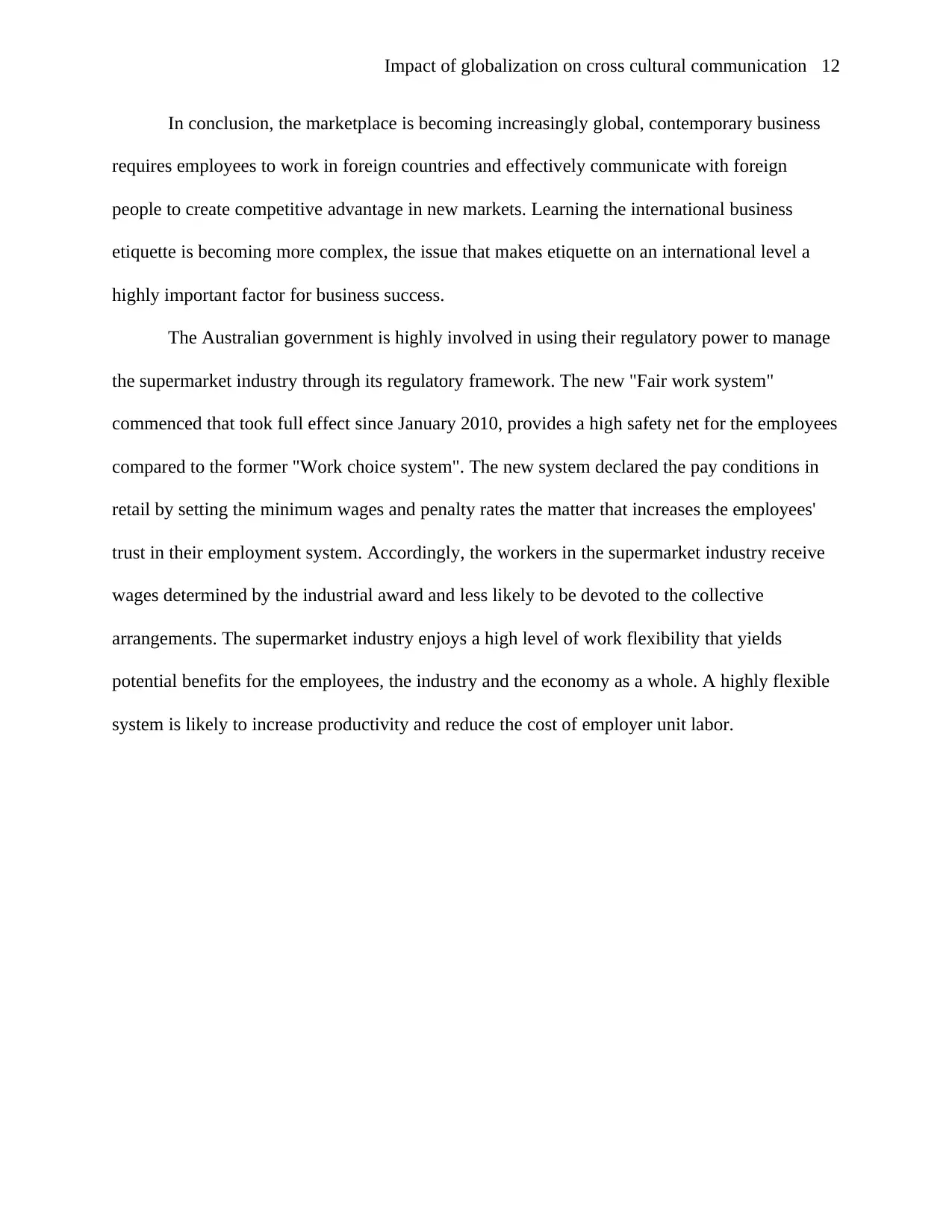
12Impact of globalization on cross cultural communication
In conclusion, the marketplace is becoming increasingly global, contemporary business
requires employees to work in foreign countries and effectively communicate with foreign
people to create competitive advantage in new markets. Learning the international business
etiquette is becoming more complex, the issue that makes etiquette on an international level a
highly important factor for business success.
The Australian government is highly involved in using their regulatory power to manage
the supermarket industry through its regulatory framework. The new "Fair work system"
commenced that took full effect since January 2010, provides a high safety net for the employees
compared to the former "Work choice system". The new system declared the pay conditions in
retail by setting the minimum wages and penalty rates the matter that increases the employees'
trust in their employment system. Accordingly, the workers in the supermarket industry receive
wages determined by the industrial award and less likely to be devoted to the collective
arrangements. The supermarket industry enjoys a high level of work flexibility that yields
potential benefits for the employees, the industry and the economy as a whole. A highly flexible
system is likely to increase productivity and reduce the cost of employer unit labor.
In conclusion, the marketplace is becoming increasingly global, contemporary business
requires employees to work in foreign countries and effectively communicate with foreign
people to create competitive advantage in new markets. Learning the international business
etiquette is becoming more complex, the issue that makes etiquette on an international level a
highly important factor for business success.
The Australian government is highly involved in using their regulatory power to manage
the supermarket industry through its regulatory framework. The new "Fair work system"
commenced that took full effect since January 2010, provides a high safety net for the employees
compared to the former "Work choice system". The new system declared the pay conditions in
retail by setting the minimum wages and penalty rates the matter that increases the employees'
trust in their employment system. Accordingly, the workers in the supermarket industry receive
wages determined by the industrial award and less likely to be devoted to the collective
arrangements. The supermarket industry enjoys a high level of work flexibility that yields
potential benefits for the employees, the industry and the economy as a whole. A highly flexible
system is likely to increase productivity and reduce the cost of employer unit labor.
⊘ This is a preview!⊘
Do you want full access?
Subscribe today to unlock all pages.

Trusted by 1+ million students worldwide
1 out of 14
Related Documents
Your All-in-One AI-Powered Toolkit for Academic Success.
+13062052269
info@desklib.com
Available 24*7 on WhatsApp / Email
![[object Object]](/_next/static/media/star-bottom.7253800d.svg)
Unlock your academic potential
Copyright © 2020–2025 A2Z Services. All Rights Reserved. Developed and managed by ZUCOL.





